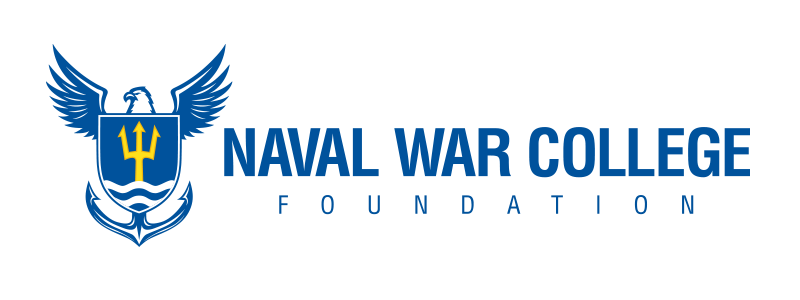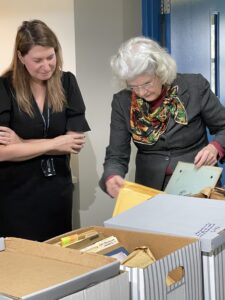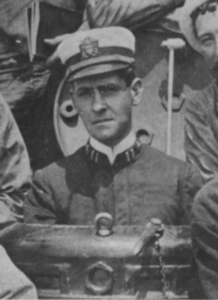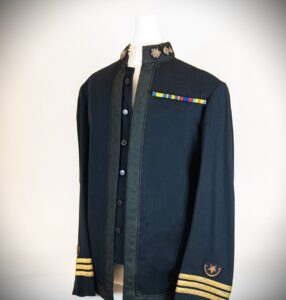The U.S. Navy Submarine Force is celebrating its 125th anniversary, commemorating the commissioning of the first modern submarine, USS HOLLAND (SS-1) on April 11, 1900. In 2022, the Naval War College Foundation (NWCF) received a collection of letters and artifacts from HOLLAND’s first commander, Lt. Harry Handly “H.H.” Caldwell Sr. Read on for an interview with Caldwell’s granddaughter, Barbara, that originally appeared in the Winter 2023/2024 issue of The Bridge.
Military participation often passes from one generation to the next. Lt. Harry Handly “H.H.” Caldwell Sr. started this tradition in the Caldwell family. Caldwell’s military career spanned from 1891 to 1909, and he documented his experiences in more than 250 letters sent home to his mother. An 1891 graduate of the U.S. Naval Academy, Caldwell Sr. served as flag secretary to ADM George Dewey at the Battle of Manila Bay. He later became the first USS HOLLAND (SS-1) commander, the first U.S. Navy submarine, commanding the ship from its commissioning in October 1900 until November 1902.
His son, Harry H. Caldwell, Jr., followed in his footsteps and spent most of his first 20 years of commissioned service in submarine billets, including wartime service on the USS DACE (SS-247) and command of SPIKEFISH (SS- 404). In 1961, he became the Commander of SUBMARINE DIVISION 22. He ended his Naval career as CO of the Fleet Training Center in Newport, RI, where years earlier, his father had participated in war games in Newport Harbor ahead of the USS HOLLAND commissioning.
In November 2022, the Caldwell family visited the U.S. Naval War College (USNWC) campus to meet with the USNWC archivist, the Naval War College Museum team, and Naval War College Foundation (NWCF) Collections Specialist Patricia Gilrein. The family shared research, personal letters, Caldwell Sr.’s uniform ca. 1900, and photographs from Caldwell Sr.’s
time on the USS PETREL (PG-2) and Caldwell Jr.’s work on the DACE and the USS SENNET (SS-408), which traveled to Antarctica. Four boxes of materials were donated to the Foundation on that first visit. The family returned to the campus in June 2023 to share even more of their family history. The collection is currently under the care of the USNWC, where it will be made available to students and faculty for research purposes.
We spoke with Barbara Caldwell, the daughter of CAPT Harry H. Caldwell Jr., USN (Ret.) about the importance of preserving these first-hand accounts and what she learned from her father and grandfather.
NWCF: How did your grandfather begin his military career?
BC: My grandfather was admitted to the U.S. Naval Academy in 1887. He could have been 14 years old, but he might have been younger. He wasn’t quite tall enough. In the letters donated to the Naval War College Museum, he describes how the Chief Medical Officer encouraged him to stand up on his toes so he could be admitted to the Academy. He eventually grew to be about 6 feet tall. These letters spurred me and my father to think about the stories that come from service and a life devoted to taking something on as who you are.
NWCF: Both your father and grandfather documented their experiences in the military. How did that start?
BC: My grandfather’s second career was in the movies. In 1915, he started working on documentaries with my grandmother. So, my father always grew up in this environment around storytelling. Knowledge is transferred through the stories of people who lived in that time. First-person history really matters, and that’s what I have come to believe my father was able to bring to the table through the life he led on submarines during WWII, in the anti-submarine warfare program, and later when he was brought to the Fleet Training Center to close it in Newport. He was seeing what he understood was the end of an era and was very much about seeing those big moments. It’s interesting because I think that’s exactly what my grandfather saw when he was working to bring the submarine online and made the trip from DC to Newport to be there for the war games. It was an entirely strategic move. It’s written
in my grandfather’s letters home. He didn’t say, “I’m doing this because…” He said, “This is an opportunity for the people in charge to see what this new exciting technology can do.” Seeing and being a part of those big moments takes a certain kind of vision, and I think they both had that.
NWCF: How did you come to share these letters and objects with the NWCF and Naval War College Museum?
BC: A USNWC archivist first contacted my mother to see if she had any papers from her husband’s time at the Fleet Training Center, saying the College and Museum would be very grateful to give them a home. I hung onto that letter until I reached out about two years ago and said we would love to share our papers. My father, when he was alive, shared quite a lot of his father’s papers with the Southport Seaport Museum. And it sort of placed New York City in the center of the international world, the way my grandfather saw New York City. But I think my dad’s papers, which were shared with you, really bring two stories into one about why the work happening at the USNWC matters and how it has transformed the Navy we had in the 1880s to the Navy we have now in the 21st century. You honor people when you show interest in something that’s near to their heart as being important to the organization. That grace the Museum and NWCF gave us allowed me to suddenly see my father as this storyteller and keeper of stories across several technologies. I know these materials are in the best
hands, with people who see their value, and it also creates an opportunity to tell a deeper story.
My father spent much of his life educating us on why stewardship vs. ownership matters. And so that’s what this was about. This donation was about stewarding these stories for the next storytellers and researchers, for whom this would be valuable. I won’t be the storyteller for the submarine service, but there are some great storytellers out there. These were all
times that Dad lived through, and he felt compelled to keep those stories alive. And he would tell you he wasn’t the best storyteller. I don’t think that’s true; he loved his writing.
NWCF: Storytelling is in the Caldwell blood. Can you tell us a bit about the work your grandparents did with documentaries and films following his retirement from the Navy?
BC: My grandparents went on and did some powerful, fun, sassy movies during the 1920s. My grandmother had a wicked sense of humor, and my grandfather liked to keep that rolling. My grandparents did the titles for “Ben Hur.” A lot of that material is in the Museum of Modern Art. The film was very special to their work. They also worked on some Greta Garbo films. They were at the top of their industry at that time until everything came to a halt with the Great Depression in 1929.
NWCF: What would you say to encourage others who may also have historically significant artifacts in their possession to encourage them to become stewards like your family?
BC: Physical items start to give dimension to our stories, rather than reading type on a page or notes from famous people. They can look at the finish on uniforms and see how beautiful the bronze medals are. Even the photography from Dad’s change of command ceremony and the changing of the guard at the Fleet Training Center is absolutely awash in pomp and circumstance. We were so impressed by the collections space. It’s clear it will be kept safe but also shared with many people.
NWCF: What would you say makes the work of the USNWC so important?
BC: We as a society seem to have split between thinking that peace is passivity but peace is actually earned. I have studied social justice and have seen the horrors that war brings to communities and the hardships it brings to nations and people living in those nations – the collective consciousness. But peace still needs to be earned. We need to have the knowledge to keep people safe and to stand up for ideals. If my father had anything, it was a remarkable moral compass, and I was very grateful to watch that in action.
NWCF: What else should people know about your father and grandfather?
BC: One thing that comes through in the collection is their sense of humor, which I think is very valuable. Their sense of strategy was born out of their commitment to our country. The other thing that came to me while going through this collection was their commitment to the crew. In the picture of the captain on the Holland, he has a crew of five around him. Every member of that crew was critical to the success of that enterprise. It became abundantly clear to him that he needed to protect these people, and it was his job to get the ship home with their help. It couldn’t have happened without them. That became his mantra in dealing with folks.
That was also absolutely the way my father saw his role when he ran the submarine school in New London. There were crazy stories of him trying to get the absolute best out of people. He knew it wasn’t his crew that was going to require that kind of great leadership. It was their crews and then their crew’s crews. It just continues from generation to generation.
The NWCF’s Collections Project is made possible in part through the van Beuren Charitable Foundation and the Institute for Museum and Library Services.
- Left: Patricia Gilrein, NWCF Collections Specialist, and Barbara Caldwell explore some of the Caldwell family’s letters.
- Lt. H.H. Caldwell Sr., USN (Ret.) in 1901. U. S. Navy official photo, property of the U.S. Naval History and Heritage Command
- The uniform of Lt. H.H. Caldwell Sr., USN (Ret.), ca. 1900.



